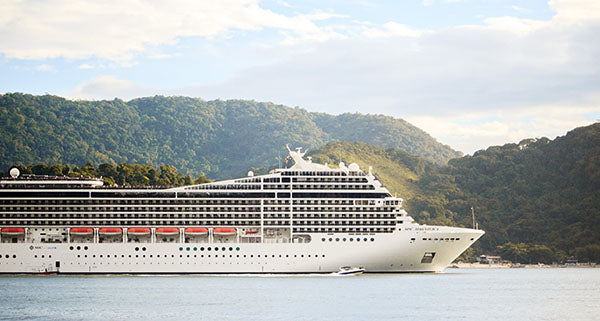The wide ocean beckons, promising fun on the high seas as you dream of cruising around the Caribbean, the Mediterranean, maybe even Alaska… but what if seasickness hits? The last thing you want is to spend a week rolling in misery in a tiny cabin. No fear! Here are our top tips for preventing seasickness before you even step on deck--and what you can do if you’re already feeling queasy.

Preventing Seasickness
Unless you are an experienced sailor, it’s hard to know how your body will react to the feeling of rocking on a boat. Even if you have taken cruises in the past without problems, a strong storm may still bring on the dreaded mal de mer. As with so many things, an ounce of prevention is worth a pound of cure. Take measures before boarding to ensure the most comfortable voyage.
- Medicines: Many cruisers will pop anti-nausea medications before boarding to prevent motion sickness. If you feel comfortable with this, choices include Dramamine (dimenhydrinate) and Bonine (meclizine), both available over the counter, and Transderm Scop (scopolamine), a patch worn behind the ear for three days, available by prescription only. Common side effects of these drugs include drowsiness and dry mouth. Alcohol can exacerbate this drowsiness, so it is advisable to avoid those daiquiris at the swim-up bar until the medicine is out of your system.
- Acupressure: Is the idea of no daiquiris too much to bear? If you want to avoid the side-effects of anti-nausea medications, wear acupressure wristbands, ideally before the onset of nausea. These have no side effects, though you should consult your doctor before wearing them if you have problems with reduced circulation, carpal tunnel syndrome, or neuropathy. One added bonus of wristbands: you can reuse them on future cruises, making them a cost-effective choice.
- Cabin selection: Select your cabin with seasickness in mind. You’ll feel the rocking of the boat less if you are staying toward the middle of the boat, close to water level. Having a window will allow you to focus on the horizon if you start to feel nauseated, helping you regain your equilibrium.
- Sleep and nutrition: Make sure you get a good night’s sleep before you embark, avoid excessive caffeine and alcohol, stay well hydrated, and eat light, easily digestible foods. If you avoid overtaxing your body before departure, you’ll be better prepared to deal with the physical stress of a turbulent sea.
Managing Seasickness
What if nausea hits unexpectedly? Try the following plan of attack:
- Run for your motion sickness bands: Again, acupressure wristbands can be helpful even once nausea hits. Many users experience relief within minutes.
- Or try some medicine: Dramamine and Bonine (or their generic equivalents) may also help relieve nausea in progress, though Transderm Scop is intended for preventative use only.
- Find a good spot on the boat: Get some fresh air, and resist the urge to go below deck; you’ll maintain your equilibrium better by focusing your gaze on the horizon. If you need to lie down, seek out a lounge chair on a lower deck, toward the center of the boat (from side to side and front to back).
- Help your stomach out: Sip lemon, ginger, or peppermint tea. These can all help calm an upset stomach.
- Get the pros: If you’re still feeling terrible, visit the cruise’s infirmary. The staff there is used to queasy travelers and will be well equipped to assist.

